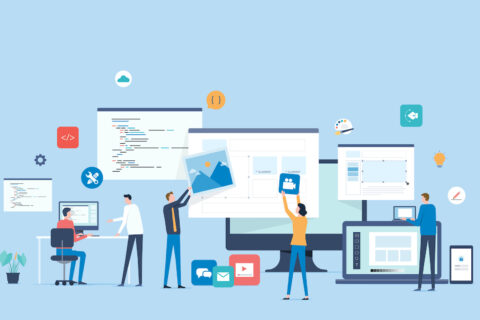The steady growth of the global SaaS market creates opportunities for entrepreneurs or investors like you to generate incremental revenue by offering a variety of Software as a Service (SaaS) products. When starting a SaaS company, you have the option to offer cloud-based solutions that help companies and startups resolve specific issues through automation.
Based on your expertise, you can offer SaaS products that help businesses automate various business processes or activities – enterprise resource planning (ERP), customer relationship management (CRM), corporate communication, project management, and business travel management.
However, you can launch and grow a successful SaaS company by offering software that helps customers solve problems better than competitors. In addition to coming up with innovative features, your SaaS product must deliver an outstanding user experience and leverage cutting-edge technologies.
At the same time, you must draft strategies to acquire new subscribers and retain existing subscribers. Here are some of the best practices you should implement today to help your SaaS startup achieve and sustain profitable growth.
1. Optimize website user experience (UX)
No business can promote and sell its SaaS products without building a robust website. While building a SaaS website, you must focus on fixing issues affecting its user experience.
For instance, you need to ensure that the website loads in less than 2 seconds on both computers and mobile devices. You must test the website regularly to attract and engage visitors by improving its speed, accessibility, usability, and security.
2. Provide DIY software
Businesses prefer SaaS software to conventional software to leverage benefits like personalization and integration. However, you must provide do-it-yourself (DIY) software where the users can customize the SaaS software application themselves without contacting your support team. You must enable subscribers to get information and answer questions without raising support tickets regularly. In addition to keeping the software easy to configure and use, your SaaS company must provide access to an extensive knowledge base. You can further facilitate self-service by enabling customers to interact with AI-powered chatbots.
3. Offer full-service implementation
You can impress customers by supporting self-service. But you should not forget that many small businesses and startups lack the technical resources required to implement and customize your SaaS software. You must complement the self-service options with assisted cloud implementation. The option will help customers configure cloud-based software and integrate it with other enterprise solutions through your team of technical experts.
4. Keep the SaaS pricing model simple
SaaS companies these days allow customers to choose from many pricing models – flat price, user-based, usage-based, and tiered. You should remember that each SaaS pricing model has its pros and cons. For instance, the tiered pricing model is customizable but confusing. Consequently, the flat pricing model may not meet the budgets of price-sensitive customers despite being simple and straightforward. While comparing the pricing models, you must ensure that the billing process remains simple and does not confuse subscribers.
5. Optimize data security
Your SaaS company can acquire and retain customers only when the software is 100% secure. Invest resources to set up safe and reliable infrastructure and reduce upfront investment by leveraging the security features of reputable hosting providers like AWS, Azure, or Google Cloud.
At the same time, you must support two-factor authentications to ensure that the SaaS software is accessed by authorized users and not cyber criminals. However, you must protect the sensitive enterprise data of customers by supporting permission-based access. The security option will ensure that a user can access relevant data only for a specific and authorized purpose.
6. Leverage proven marketing strategies
You can increase subscribers by driving site traffic regularly. To do this, implement impactful and proven marketing strategies for SaaS businesses, including search engine optimization (SEO), content marketing, referral marketing, retargeting, and co-marketing. It’s also essential to regularly monitor and boost individual marketing campaigns’ performance.
7. Offer a software trial or demo
Most companies allow potential customers to evaluate their SaaS products before subscribing (e.g., a free trial or product demo). A SaaS free trial will create opportunities for the subscriber to evaluate your software for a specific duration using specific features. On the other hand, a SaaS product demo will require your employee to display various features of the software to the customer. You should support a free trial or product demo by focusing on vital factors like the nature of the software, type of the company/startup, sales cycle, and product longevity.
8. Automate business travel
When you support product demos, your marketing professionals or technical experts will display various software features by visiting the client. By implementing the right travel management software, you must make it easier for traveling employees to visit the client. Travel management software will help work travelers book flights, accommodations, car rentals, and similar business travel products. Also, the software will make it easier for your business to keep them safe and secure by providing travel updates and real-time support.
9. Future-proof your SaaS software
Enterprises investing in SaaS software expect regular updates. You can impress and retain subscribers by updating the software by adding new features and leveraging new-generation technologies. Cutting-edge technologies like artificial intelligence (AI), machine learning, and 5G have consistently transformed SaaS software. You must leverage these technologies to make the SaaS product solve business problems more effectively.
Sustaining profitable SaaS growth
Generate recurring and incremental revenue by launching SaaS software that helps businesses resolve specific problems. A SaaS company can sustain profitable growth by meeting customer expectations and outperforming competitors. So, search for new ideas and implement new best practices regularly to make your SaaS company successful in the long run.
Sharad Acharya is a content specialist at ITILITE. With over 8 years of experience in writing for diverse industries, such as travel, cloud, finance, and accounting, he has extensive experience in different niches, including AI, SaaS, Big Data, IoT, and more. A bookworm, he likes to read fiction in his leisure time. He also likes to go on long rides to clear his head and collect his thoughts.
© YFS Magazine. All Rights Reserved. Copying prohibited. All material is protected by U.S. and international copyright laws. Unauthorized reproduction or distribution of this material is prohibited. Sharing of this material under Attribution-NonCommercial-NoDerivatives 4.0 International terms, listed here, is permitted.














